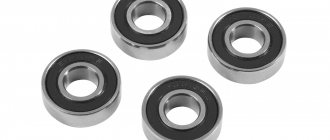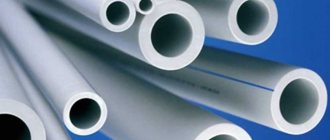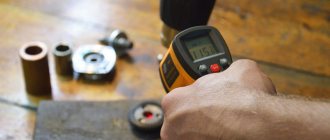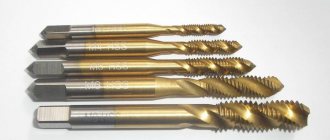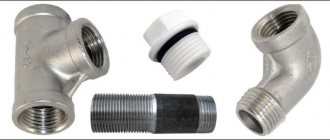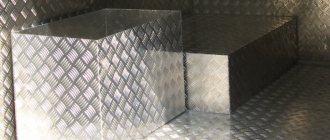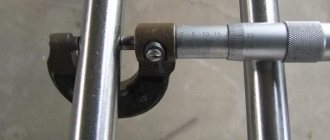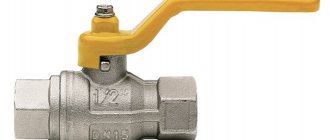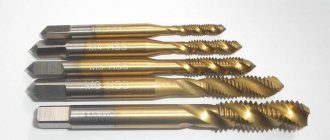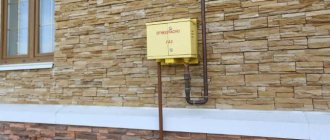Nowadays, radial ball bearings with one row of rolling elements are the most common type of shaft and axle supports. These products are used in a wide variety of components and mechanisms where rotation occurs at a fairly high frequency and the values of radial forces are relatively small. Ball bearings of this type are in demand in the automotive and mechanical engineering, instrument making, food and pharmaceutical industries, in the energy sector and in the manufacture of household appliances. The simple non-separable design makes these parts affordable and easy to maintain. If such a ball bearing is manufactured in accordance with high quality requirements, correctly installed and lubricated, then its service life is very long.
How to determine its main dimensions and type based on the bearing markings?
In accordance with the accepted system of symbols for bearings, the numbers in the markings are counted from right to left.
The first and second numbers (on the right!) indicate the diameter of the shaft at the landing site (inner diameter of the bearing). Internal diameters from 10 to 20 mm are designated as follows:
| Nominal hole diameter, mm | 10 | 12 | 15 | 17 |
| Symbol | 00 | 01 | 02 | 03 |
| Example | 200 | 201 | 202 | 6203 |
For bearings with an internal diameter of 20 mm and larger (up to 495 mm), the same first and second digits show the quotient of the diameter size divided by 5. For example, the two rightmost digits 04 mean that the internal diameter of the bearing is 20 mm; numbers 25 correspond to a diameter of 125 mm, etc. The third and seventh numbers indicate the series of bearings by diameter and width, respectively. The fourth indicates the type of bearing: radial ball single row - 0; radial ball double-row spherical - 1; radial with short cylindrical rollers - 2; radial roller double-row spherical - 3; roller with long rollers or needles - 4; roller with twisted rollers - 5; angular contact ball - 6; roller conical - 7; thrust ball - 8; thrust roller - 9.
These are, of course, only the most general designations. It is simply impossible to present everything in a short answer.
Series
bearing is one of the normal rows established by the standards, differing from each other in the diameter of the outer surface and width with the same design and bore diameter. The type of bearing determines its basic properties: the direction of rotation and the shape of the rolling elements.
Having trouble choosing the right type or type of bearing?
Don't want to waste time browsing through an extensive catalog of thousands of items?
Do you want to quickly get all the necessary information in one place?
I tried to make the choice as simple and convenient as possible. To do this, we suggest using the online bearing selection form. Just enter the characteristics in the appropriate fields and get quick results.
Do you know the number of the bearing you need?
The choice will be even easier. It is enough to enter the marking in the appropriate field for selecting bearings by number to obtain data on availability and prices.
Differences from plain bearings
There are two types of moving parts in mechanisms: supports based on sliding friction and supports based on rolling friction.
When using the former, the working surfaces of the housing and shaft mutually move and interact, most often separated by lubricants and a sliding liner. The support works when there is pure sliding in the parts that come into contact.
With the second version of supports, rolling bodies (these can be rollers or balls) are placed in the gap between the surfaces that move mutually. In this case, the supports operate using rolling friction. In such cases, instead of bronze, babbitt or plastic liners in the bearings where rolling friction is applied, ball or roller bearings made of steel are used.
In accordance with the nature of the load of rotation supports, they are radial, when a radial load is applied to the support, thrust, when the support is subjected only to axial loads, and radial thrust, when both types of loads act on the support together.
Each type of support has its own size, design, technical conditions for production, installation and maintenance.
Rolling bearings and sliding bearings have different mechanisms for resisting movement and determining the wear of parts of moving supports. The type of required unit is determined based on an assessment of the operating procedure of the mechanism or its individual units.
Correct selection of bearings
Correct selection of bearing sizes directly affects the reliability of equipment. But in order to ensure long-term maintenance-free operation of the mechanisms, it is important to take into account other parameters:
- Magnitude, direction, nature of the load. Bearings of different types can accommodate radial, axial or mixed loads.
- The number of revolutions of both rings per unit time.
- Working life, expressed in working hours or number of revolutions over the entire service life. This is one of the most important parameters characterizing the durability of the mechanism.
- Features of the environment in which the bearing will be operated.
Using the bearing selection form on our website, you can select products of the size you need and compare their performance characteristics. After this, all you have to do is place an order for the desired product.
The choice of product is also influenced by specific requirements, depending on the operating characteristics of a particular unit. always helps his clients. Our specialists will advise you on any issue and help you choose the right bearing. We do everything to make cooperation with us as convenient as possible for you. If you have any questions or need additional information, just call us at 8 (812) 333-00-90 or request a call back.
The variety of types and shapes of support nodes makes it difficult to choose a specific one. You can select a bearing by size from the table online. It's actually not that difficult to decide. To do this, you need to carry out a simple procedure for measuring an existing part that needs to be replaced or use already known parameters. If you follow the rules, you can select a specific model and order its purchase without leaving your home. Let us consider in detail how to do this so as not to make mistakes when purchasing new spare parts.
How to choose online bearings by size
There are many online services that provide the opportunity to select a part based on various parameters. Most often, 3 main quantities are used for searching:
- • inner diameter;
- • width (or height);
- • external diameter.
It is important to enter numerical data correctly. First of all, the internal hole of the support assembly is measured, then its external dimensions and only after that the width of the part.
Based on the search results, not one, but several supports with the same parameters and analogues for each of them can be returned. Some services even give an approximate cost for a particular type of part. All that remains is to choose the most suitable one in terms of price and availability.
Forms
Sometimes you can select based on other parameters: a specific name or type. So, you can easily find several analogues if you cannot purchase an original nodal support.
Even knowing all the parameters and observing the correctness of entering data into the search form, it can be difficult to settle on a specific choice. In this case, the staff will provide assistance. They will help you choose the most suitable option based on the characteristics of the machine in which the product will be used.
Advantages and disadvantages of ball single-row radial bearings
The undeniable advantages of radial single-row ball bearings include their high speed characteristics. These supports have proven themselves to be excellent in mechanisms with high shaft rotation speeds. Consumers are also attracted by the moderate price of these parts, due to the relatively simple production technology, as well as the ability to choose the size and design from a variety of proposed options. But these products also have a number of important disadvantages: • Bearings using a ball do not tolerate moment loads well; • Single-row type of supports does not have sufficient axial rigidity; • The carrying capacity of the products is limited; • Susceptibility to pollution; • The supports do not withstand vibrations and shocks well. In some cases, a double-row bearing, which is stiffer and more load-bearing, helps out. But, if the operating conditions of the unit are quite severe and there are doubts about the reliability of the ball design, experts recommend using roller models, the internal diameter and external size of which correspond to the parameters of radial rolling bearings with balls.
How to choose the right size online
You have to measure the main values of the reference unit yourself, and at this stage you can make several mistakes if you don’t know some tricks.
How to select a bearing according to the inner diameter of the shaft - d
Most questions are associated with its definition, since many types of products have a specific shape. When measuring, you must remember:
- • When selecting an element with a tapered hole, the internal diameter is measured along the smallest side.
- • Thrust bearings use a tension ring to determine the size.
- • If the part is accompanied by a sleeve, then it is inside it that the measurement is taken.
- • If the shape of the internal hole is different from circular, the calculation is carried out along the inscribed circle.
Sometimes the support unit is made without a ring at all. Then the diameter is measured not on the product itself, but on the working shaft. Knowing such little things, it will be much easier to find the bearing number by size online.
Calculation of external diameter – D
Regarding this parameter, everything seems much easier and in most cases, it is so. There are only two nuances. The first concerns the missing outer race ring. If your part has this feature, you can measure the value using the seat.
The second concerns technical characteristics. The outer diameter is classified into spherical and bombed type. The latter is found only in support roller ones and is associated with their complex profile. Unlike the internal diameter, the external diameter can have two values at once: standard and a parameter measured along the locking part.
Width calculation – B
When measuring this part of the part, it is necessary to take into account several nuances that relate to a specific type of product. For example, in a thrust-conical assembly, the ends of the cage may not be the same. In this case, the width is the difference in the dimensions of the two rings. It is important to take measurements in parallel. If difficulties still arise, it is better to seek advice from a specialist.
Rules for working with bearings
A bearing must be reliable, but sometimes the conditions in which it must rotate are not suitable for its normal functioning.
Also, conditions can also influence the fact that a bearing, even in good conditions, can suddenly fail. Therefore, there are special rules for the operation of this part, and they should be taken very seriously so that your part can work as long as possible. For example, you should not overload it and make sure that it only works for the required time period and no more. Another rule should be considered that it should be selected so that it fits perfectly in size, diameter and other technical characteristics.
For example, by size you can find a variety of bearings: from miniature to the most gigantic sizes. There is another division: high-speed, low-speed, maximum precision and others. All of these divisions depend on where and how you intend to use this important element of the rotational movement.
Selection of bearings according to parameters
The technical characteristics of the products are not limited to the listed values. The choice is influenced by many other data:
- • The maximum magnitude of the load by its nature and direction. Some parts can only handle radial and axial pressure, while others can handle mixed loads successfully.
- • Number of maintained revolutions per minute. The best performance here is characteristic of nodal rolling bearings.
- • Accuracy class, on which the rotation of the device, and hence the overall operation of the structure, depends.
- • Type of lubricant used (liquid, gas, etc.).
- • The moment of fatigue, that is, the maximum service life of the product.
- • Noise and vibration levels.
- • The actual dimensions, which have already been discussed earlier.
It is also important to take into account the operating conditions of the bearing, including temperature conditions, the ability to use it in water and other features. It can be difficult for the average person to decide on a specific type of support, and the selection form on the Internet is very limited and does not take into account most of the listed parameters. So it can be difficult to do without additional consultation from specialists, especially if the product is purchased to operate an expensive machine.
Single row radial ball bearings
The most popular type of rolling bearings. Often used in the designs of a wide variety of equipment. It includes rollers for cardboard machines, gearboxes, and electric motors. They are used to resist radial loads, but can also be prepared to withstand double-sided axial loads. They are often used exclusively for axial loads, especially if the shaft speed is high and thrust bearings cannot be used. If the radial clearance increases, then the axial load capacity of the bearing also becomes greater, since in this situation the bearings acquire the characteristics of angular contact bearings. The bearings can operate if the relative misalignment of the inner and outer rings is no more than 20°.
As for the rolling bearing housing, it is most often made of gray cast iron. The material for single-row bearing cages is steel stamping or antifriction materials such as textolite, brass, bronze, duralumin. Recently, polyamide resins have been used to produce separators. If the bearings have a high accuracy class and massive turned cages, which are centered along the outer ring using effective lubrication modes, then they can operate even at rotation speeds that exceed the maximum limits described in reference books.
Design types of single row radial bearings:
- having one protective washer;
- having two protective washers;
- having a groove on the outer ring and an installation ring;
- having an installation ring and a protective washer;
- having one-sided and two-sided sealing;
- having a groove for introducing balls without a separator.
Purpose
There are 3 widely used types: sliding, rolling and magnetic. They differ in their design and scope of use. The first group consists of a body with a hole, a bushing and a lubricating device. To operate such a product, a large amount of lubricant is required, so a technician is required to regulate its supply. Today, this type of parts is used less and less, but they can be found in any equipment that requires high-speed operation, in steam and turbine installations, in navigation systems and many other high-precision devices.
Rolling bearings are by far the most commonly used. Basically, bodies are made in the form of balls and rollers. The main difference between these products and the first type is that there is no need to constantly lubricate the structure. The element can be used for a long time without this material, which means constant supervision by a specialist is not required. The variety of rolling bearings allows them to be used literally everywhere: from electric motors to household appliances, from complex industrial machines to medical equipment.
Magnetic devices are a structure that operates on levitation. It may include the product itself, an electronic system for monitoring its operation, or permanent magnets. The scope of application of such parts is very wide and unusual compared to others. They are often used in complex gas centrifuges, cryogenic technology, turbomolecular pumps and other mechanisms.
It is the specific type of bearings that becomes the basis of choice, since these parts are not interchangeable, although they can protect each other.
Advantages and disadvantages
Rolling and sliding bearings have both pros and cons. Rolling bearings can be preferred over plain bearings due to the lower level of friction at low speeds and when starting from a standstill. Also, rolling bearings have smaller axial dimensions, which makes it easier to assemble the structures of self-aligning supports, without requiring a long time for difficult individual adjustment of liners and their running-in. This is especially important for journals with large diameters, operating under heavy loads, at high rotation speeds and temperatures.
When a rolling bearing is used, the quality of lubrication of machine parts and components, the quality of their maintenance are improved, and the life of the seating surfaces of cylinder journals and shafts is extended. Therefore, they are ideal for the vast majority of equipment supports.
True, in addition to advantages, rolling bearings also have a number of disadvantages.
For example, large dimensions. Such structural elements are widely represented in mechanical engineering equipment, are produced in small series and are very expensive. The rolling bearing is inferior to competitors in such parameters as radial dimensions, weight and rigidity.
It is very difficult to choose them correctly when high rotation speeds are combined with high loads. It is well known that as the load and rotation speed of a unit increases, its durability decreases. For example, if the load is increased by a quarter compared to the previous one, then the service life is reduced by half, and if the load is doubled, the service life becomes 10 times less.
Classification according to various criteria
All types of nodal supports are classified according to different features, and some of them even according to several. What is common is the division according to the type of perceived load. According to it, all devices, regardless of whether they provide rolling or sliding, can be divided into:
- • Radial – remove a perpendicular load directly from the axis of the part.
- • Thrust – take the load from the shaft axis.
- • Thrust-radial or radial-thrust – combine the properties of the first and second.
The strength of the perceived load can also vary, so it is not enough to select a bearing based on its type; the maximum force must also be taken into account.
Another general indicator for classification is dimensions. According to them, all supports are divided into series. Each combines information about diameters and widths. Each device can be assigned a number from 0 to 9, with non-standard sizes designated 6, 7 or 8.
And finally, the most important indicator for classification is design features. Here the variety is very wide and is indicated in the markings by two-digit values from 00 to 99. For example, rolling bearings are divided into ball and roller bearings according to the shape of the body. The first are further divided into:
- • Cylindrical.
- • Conical.
- • Needle-shaped.
- • Spherical.
This variety allows you to increase the perceived load, noise and vibration levels, wear resistance, rotation speed and so on. Ultimately, all bearings are individually marked, taking into account the features of the device. It specifies the diameter, dimensions, type, design differences and some additional signs for complex parts.
The search for a new nodal support should begin by studying the instructions for the old one. All parameters must be specified in it. If such information is not available, selection is made by size. Then, taking into account the operating conditions and the specific characteristics of the machine into which the support is inserted, other basic indicators are selected. Assistance in choosing when purchasing will be provided by specialists who have extensive experience and understand all the intricacies of the process.
Marking and dimensions according to GOST
Requirements for components and parts are formulated by GOST. Rolling bearings are described by GOST 520-2002.
The symbols are based on the following parameters:
- the diameter that the bearing bore has;
- series of widths (or heights) and series of diameters;
- types of bearings;
- technical implementation.
How to correctly determine the dimensions of rolling bearings based on the markings? The notation table will help you cope with this task.
All the above parameters are indicated by signs (or numbers).
What numbers the bearing marking consists of depends on the places they occupy in its symbol, if read from left to right: GOST for plain bearings
| The first and second numbers indicate the hole diameter (if we are talking about a hole diameter greater than or equal to 10 mm). |
| The third digit indicates the series of diameters. |
| The fourth digit determines the type of bearing. |
| The fifth and sixth digits give an idea of the design. |
| The seventh digit indicates a series of widths (or heights). |
Benefits of bearings
Each type of support unit has its own unique advantages and disadvantages. But there are also common advantages, which is why their exploitation is so widespread.
Firstly, the operating time of the machine increases, since small parts take on an impressive part of the load. Accordingly, wear occurs later, and repairs are required much less frequently. Secondly, with the help of these products it is easy to increase the accuracy of certain parts of the structure. Thirdly, servicing the mechanism requires less effort, time and money. And finally, they are able to expand the functionality of the equipment in which they are built.
Pros and cons of using
The design features of parts directly affect their useful properties and disadvantages. Let's look at them separately.
Rolling
Among the undoubted advantages of this type of device are:
- • Low cost. This factor is especially relevant given that in some complex mechanisms up to several hundred support units can be used simultaneously.
- • Low friction does not lead to serious losses and strong heating. And in general, the supports behave equally well both at the start of operation and in an already established stable operating mode.
- • A wide variety does not exclude the interchangeability of parts, and easy installation allows you to make repairs quickly and efficiently.
- • For normal operation, virtually no lubricants are needed.
- • Overall, much less care and attention is required to the parts in which these products are installed.
On the downside, rolling devices are quite susceptible to shock and vibration loads due to their rigid design. This precludes their use in some machines. In terms of their dimensions, the products that provide rocking are large, and the work takes place in quite a lot of noise.
Slip
Among the advantages of use are:
- • Small size.
- • The design can be either detachable or prefabricated.
- • Performance in high-speed mechanisms is significantly better than that of other devices.
- • They are resistant to shock waves and vibrations, which increases the possibility of operation.
- • Works in the most adverse environmental conditions.
Among the disadvantages are:
- • The need for constant monitoring of the lubricant level, since without it the technical characteristics deteriorate significantly.
- • During start-up, large losses occur.
- • Efficiency is lower than in rolling bearings.
- • Expensive raw materials are used for production, which increases the overall price.
- • Components are produced unevenly, which complicates the maintenance of the entire machine as a whole.
You can search for a bearing by size online, but many other key parameters will still have to be determined additionally. With the right choice, you can ensure stable operation of the machine and reduce the need for maintenance. Sometimes it is better to seek help from professionals who will answer your questions and advise which option to choose.
Ball bearings with one shield
They are produced exclusively with separators made by stamping. Their use at high speeds is undesirable. When working with such bearings, greases are used. A metal shield that is pressed into a groove in the outer ring can only hold lubricant on one side. On the reverse side, the lubricant contained in the bearing is limited by a cover or seal in the assembly. The resulting space is partially filled with lubricants selected for special operating conditions. This design option for a part always makes it possible to inspect it (at the place of the cover or seal) and carry out additional lubrication as work progresses.
